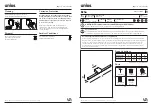
4 Operation
Rittal Perforex BC machining centre
31
EN
device would need to remain in operating mode an extended time. This,
however, would mean that the medium flows very slowly to the jacket spray
nozzle. To accelerate this process, the device has a flooding screw located
inside the oil quantity control. This allows the flow speed to be increased so
that the long lines are filled quickly with the medium. This process prevents
long wait times before the initial use. A fast flooding is also required if the
system is inadvertently run dry.
1. Connect the compressed air supply (Fig. 20, item 1) to the device.
2. Set the container internal pressure with the pressure regulator (Fig. 20,
item 4) on the manometer (Fig. 20, item 6) to at least 2 bar.
3. Close the secondary air supply (Fig. 20, item. 3) completely.
4. Switch on the device and align the spray nozzle downwards to the oil
collecting tray.
5. Loosen the fastening screw on the rotary knob (Fig. 20, item 7) of the oil
quantity control and remove it.
6. Open the internal spindle (see Fig. 20) by one turn to increase the oil
flow.
7. Switch the outlet of the coaxial hose (Fig. 20, item 8) during flooding
"On/Off" several times with the magnetic valve, optionally manual slide
valve (Fig. 20, item 2) to flush air and air bubbles from the capillary hose.
8. Close the internal spindle again when bubble-free oil exits at the nozzle
(see Fig. 20).
9. Mount and tighten the rotary knob (Fig. 20, item 7).
10. Operational device.
4.3 Error messages
4.3.1 Troubleshooting
Proceed in a systematic and targeted way, even when under time pressure.
Indiscriminate, impetuous dismantling and changing of the setting values
can result in making it impossible to determine the original error cause.
Danger!
Danger to life when touching live parts!
Before opening the machine, it must be disconnected from
the power supply.
Proceed as follows for troubleshooting:
Obtain an overview of the system function.
Attempt to clarify whether the system provided the required function before
the error occurred.
Attempt to acquire the changes.
Have the operational conditions or the field of application changed?
Have changes (e.g. upgrades) or repairs been made to the complete sys-
tem (plant, electrical system, controller)? If they have: Which?
Was the system operated in accordance with its intended use?
How does the malfunction make itself apparent?
Clearly identify the fault cause. If necessary, question the directly-involved
operator or the plant operator.
















































